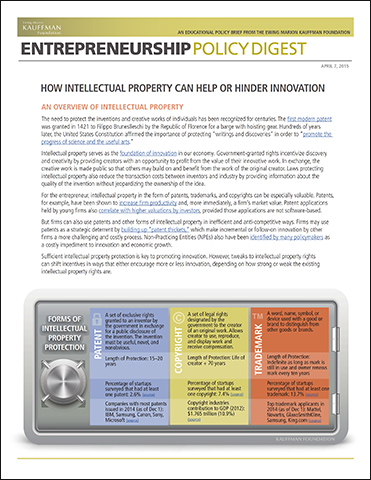How Intellectual Property Can Help or Hinder Innovation
Although intellectual property protections can increase productivity and firm valuations, they also can be inefficient and hinder innovation if they are too weak or too strong.
Written by Jason Wiens and Chris Jackson
April 6, 2015
- Facebook
- LinkedIn
- Twitter
Download the Policy Digest

How Intellectual Property Can Help or Hinder Innovation | Entrepreneurship Policy Digest
An Overview of Intellectual Property
The need to protect the inventions and creative works of individuals has been recognized for centuries. The first modern patent was granted in 1421 to Filippo Bruneslleschi by the Republic of Florence for a barge with hoisting gear. Hundreds of years later, the United States Constitution affirmed the importance of protecting “writings and discoveries” in order to “promote the progress of science and the useful arts.”
Intellectual property serves as the foundation of innovation in our economy. Government-granted rights incentivize discovery and creativity by providing creators with an opportunity to profit from the value of their innovative work. In exchange, the creative work is made public so that others may build on and benefit from the work of the original creator. Laws protecting intellectual property also reduce the transaction costs between inventors and industry by providing information about the quality of the invention without jeopardizing the ownership of the idea.
For the entrepreneur, intellectual property in the form of patents, trademarks, and copyrights can be especially valuable. Patents, for example, have been shown to increase firm productivity and, more immediately, a firm’s market value. Patent applications held by young firms also correlate with higher valuations by investors, provided those applications are not software-based.
But firms can also use patents and other forms of intellectual property in inefficient and anti-competitive ways. Firms may use patents as a strategic deterrent by building up “patent thickets,” which make incremental or follow-on innovation by other firms a more challenging and costly process. Non-Practicing Entities (NPEs) also have been identified by many policymakers as a costly impediment to innovation and economic growth.
Sufficient intellectual property protection is key to promoting innovation. However, tweaks to intellectual property rights can shift incentives in ways that either encourage more or less innovation, depending on how strong or weak the existing intellectual property rights are.
A Framework for Evaluating Patent Policy
The Dangers of Too-Weak Patents
- Weak patent protection can lead to suboptimal innovation, since the potential payoff for a private actor may be deemed insufficient for the amount of time and resources put into developing an invention.
- Because weak rights make it more expensive to protect inventions, firms tend to look inward to solve problems that may otherwise have been more efficiently solved by an inter-firm partnership.
- Patents (and copyrights) allow employers to see the exact results of the creativity and skill of prospective and current employees. When rights are weak, workers have trouble quantifying their value.
The Dangers of Too-Strong Patents
- Expansive patent rights make successive innovative activity more costly. Having to seek permission from all related patent holders bids up the cost of innovation.
- Overly strong patent rights disproportionately benefit large firms. Larger firms are more likely to use patents to entrench their position in the market, as opposed to small- and medium-sized firms that are more likely to use patents to accumulate revenue and enhance their reputation.
- When patent rights are stronger, firms with intellectual assets are emboldened to threaten other inventors with litigation. For example, NPEs often discourage innovation by more productive innovators.
Seeking a Goldilocks Approach
When intellectual property rights are too strong or too weak, they reduce the incentives for innovation. Consider the following to strike the right balance:
- It is important to encourage follow-on innovation that can dramatically add value to pioneering inventions. The current system, however, advantages those who don’t research existing patents in the field for fear of litigation. Patent policy should protect inventors who genuinely attempt to avoid existing patents and punish inventors who willfully ignore previous patents.
- Ambiguous or broad patents are hindrances to growth, especially for software patents. The broadness of a patent increases the likelihood that companies will accidentally infringe, and thus increases the likelihood of patent litigation (which can easily cost more than $500,000).
- Many patents held by companies and inventors are not practiced, but are owned just in case of potential infringement. This practice is wasteful and prevents patents from being put to their most efficient use. Dramatically raising maintenance fees would ensure that the remaining, still-maintained patents are actually worth the protection they are given.
For More Information
Click on the links for access to the following Kauffman Foundation resources:
- Read Rules for Growth to see how policy and law can promote innovation.
- Watch Kauffman Founders School videos about developing an intellectual property strategy and creating an intellectual property-conscious environment.


